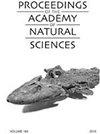双壳目:蛭形蝇科蛭形蝇的形态鉴定:属的更新诊断、2个新种的描述、lopesi的重新描述和新大陆蛭形蝇类幼虫孵化的首次记录
IF 0.5
4区 环境科学与生态学
Q4 BIODIVERSITY CONSERVATION
Proceedings of the Academy of Natural Sciences of Philadelphia
Pub Date : 2017-11-01
DOI:10.1635/053.166.0112
引用次数: 7
摘要
摘要。Rheodreissena Geda等人,2018,最近描述的一个Dreissenidae属,以生活在巴西和委内瑞拉内陆淡水中的物种为代表。Rheodreissena的模式种是R.hoeblichi(Schütt 1991a),描述于委内瑞拉下奥里诺科盆地。本研究增加了三个物种:托坎廷斯和新谷盆地的R.lopesi(Alvarenga&Ricci,1989);马德拉、特隆贝塔斯和新古盆地的cordilineata n.sp.,以及塔帕霍斯和新古流域的R.xinguana n.sp。这三个物种是在Volta Grande记录的,该河段是受贝洛蒙特大坝复合体影响的新谷河。所有Rheodreissena通常以浅集群的形式附着在与大型清澈河流主河道中的急流相关的干净岩石基底上。Rheodreissena的物种在外壳形态和软解剖方面有区别,这可能反映了对亲流变生活方式的适应。在Rheodreissena的Xingu和Tocantins种群中,在雌性(所有三个物种)的ctenidial(R.lopesi和R.xinguana)和Palial腔中观察到幼虫孵化。苍白窝的例子包括新冠R.singuana n.sp.中的一些前丝孔蛋白-1(D形)幼虫,cordilineata中代表三个不同阶段(前丝孔蛋白酶1和2,溶解螺)的24个幼虫/幼体,以及洛佩西R.lopesi中代表相同三个阶段的多达65个幼虫/幼年。在R.cordilineata和R.lopesi中,前丝孔通过一个修饰的膜(粘附膜)附着在亲代地幔上,而溶解螺的长度分别为800µm和987µm。对于在Palial腔中孵化的幼虫,在R.lopesi中统计证明了双相生长模式,并通过在R.cordilineata中的观察确定了这一模式。据推测,幼年海螺在爬行阶段会逐渐释放到环境中。双相育婴(ctenidial和paldial)先前曾被描述为欧洲洞穴居住的dreissenid物种Congeria kuscheri;注意到了Congeria和Rheodreissena的育婴差异。总结了Rheodreissena种的各种形态和生活史特征,并将其与灰蝶科的其他活种:Mytilopsis leucophaeata、M.sallei、Dreissena polymorpha、D.rostriformis(ex.bugensis)和Congeria的三个名义种进行了比较。本文章由计算机程序翻译,如有差异,请以英文原文为准。
Morphological assessment of Rheodreissena (Bivalvia: Veneroida: Dreissenidae) with an updated diagnosis of the genus, descriptions of two new species, redescription of R. lopesi, and the first account of larval brooding in New World dreissenids
ABSTRACT.
Rheodreissena Geda et al. 2018, a recently described genus of Dreissenidae, is represented by living species that inhabit inland freshwaters of Brazil and Venezuela. The type species of Rheodreissena is R. hoeblichi (Schütt 1991a) described from the lower Orinoco basin, Venezuela. Three species are added in this study: R. lopesi (Alvarenga & Ricci, 1989) from the Tocantins and Xingu basins; R. cordilineata n. sp. from the Madeira, Trombetas and Xingu basins, and R. xinguana n. sp. from the Tapajós and Xingu basins. Those three species are recorded from Volta Grande, the stretch of the Xingu River impacted by the Belo Monte dam complex. All Rheodreissena typically attach in shallow clusters to clean, rocky substrates associated with rapids in the main channels of large clear water rivers. Species of Rheodreissena are distinguished by aspects of shell morphology and soft anatomy that presumably reflect adaptations to a rheophilic lifestyle. In Xingu and Tocantins populations of Rheodreissena, larval broods were observed in the ctenidial (R. lopesi and R. xinguana) and pallial cavities of females (all three species). Examples of pallial broods included a few prodissoconch-1 (D-shaped) larvae in R. xinguana n. sp., 24 larvae/juveniles representing three different stages (prodissoconch 1 and 2, dissoconch) in R. cordilineata and up to 65 larvae/juveniles representing the same three stages in R. lopesi. In R. cordilineata and R. lopesi, the prodissoconch is attached to the parental mantle via a modified velum (adhesivelum), and dissoconchs attain lengths of 800 µm and 987 µm, respectively. For larvae brooded in the pallial cavity, a biphasic growth pattern was demonstrated statistically in R. lopesi and determined by observation in R. cordilineata. Juveniles are presumably released gradually into the environment at the crawl-away dissoconch stage. Biphasic brooding (ctenidial and pallial) was previously described for the European cave-dwelling dreissenid species Congeria kusceri; differences between brooding in Congeria and Rheodreissena are noted. Various morphological and lifehistory traits of species of Rheodreissena are summarized and compared to the other living species of Dreissenidae: Mytilopsis leucophaeata, M. sallei, Dreissena polymorpha, D. rostriformis (ex. bugensis), and the three nominal species of Congeria.
求助全文
通过发布文献求助,成功后即可免费获取论文全文。
去求助
来源期刊

Proceedings of the Academy of Natural Sciences of Philadelphia
生物多样性保护-生物多样性保护
自引率
0.00%
发文量
4
期刊介绍:
The Proceedings (ISSN 0097-3157) has been published continuously since 1841. Many volumes are still available in their original printings. Early volumes are unbound, constituting two or three issues per year. Quantities of some volumes may be limited. Early volumes may have slightly soiled cover sheets, but the text blocks are perfect.
 求助内容:
求助内容: 应助结果提醒方式:
应助结果提醒方式:


